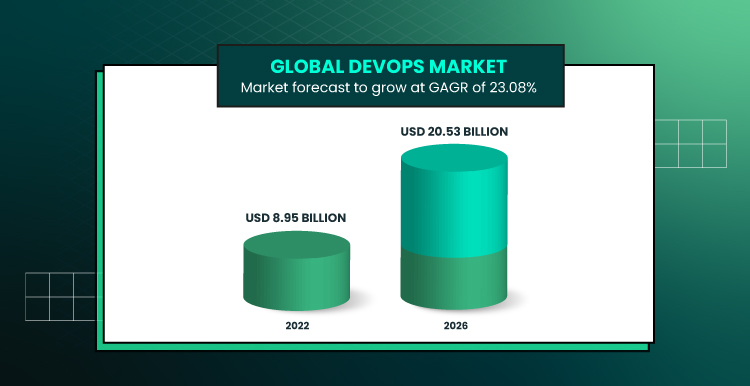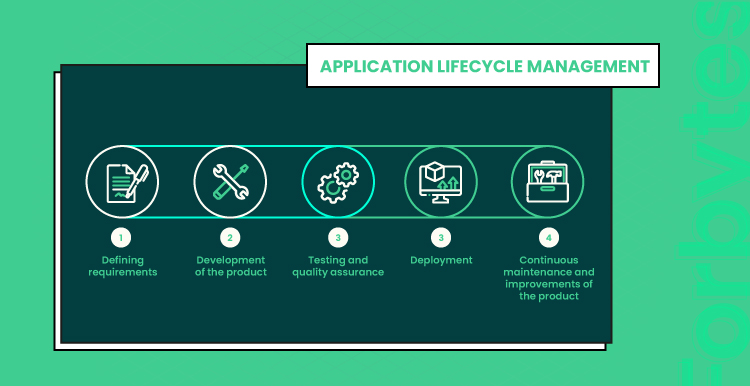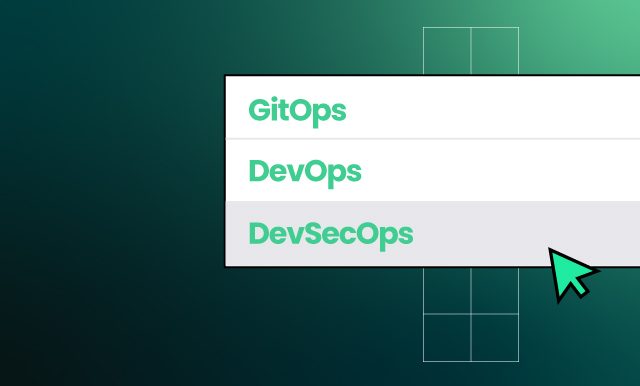Companies need to understand the key differences between the three integral operational methodologies to choose the right approach to software development and infrastructure management. GitOps vs DevOps vs DevSecOps brings something different to the software development process. Let’s discover the differences between them.
What Is DevOps?
DevOps is a set of practices that combines software development and IT operations to shorten the systems development life cycle while delivering features, fixes, and updates frequently in close alignment with business objectives. DevOps was invented in 2009 due to an increased focus on collaboration and communication between IT developers and other stakeholders across the entire software delivery process. By using DevOps principles and practices, teams can more quickly deliver application features while incorporating feedback more smoothly into their projects.
This way, organizations can produce better results faster by sharing responsibility for infrastructure, operations, security management, releases, and automation.
The DevOps industry is anticipated to grow at a CAGR of 23.08% to $20.53 billion by 2026.

DevOps leverages several approaches like continuous integration, continuous delivery, and infrastructure as code, including automated testing and deployment tools that can speed up product release cycles.
DevOps workflow is as follows:
- Preparing in accordance with the needs;
- Building the features and coding;
- Testing to find and fix faults and bugs;
- Carrying out operations;
- Launching the program;
- Checking the application continuously for problems.
Because it encourages a culture of ongoing feedback, teams can quickly identify where any issues may arise and address them before broader implementation. The DevOps methodology has revolutionized software development, creating leaner organizations focused on delivering faster solutions through collaboration and cooperation.
What Is GitOps?
GitOps is a popular DevOps approach, combining Git and continuous delivery technology to enable full-stack teams to quickly transfer infrastructural changes from the development environment into a production setting. It enables developers to be more involved in the deployment of code, making it possible for them to set automated triggers that turn their feature branches into deployments when their code passes specific tests.
The following is a basic description of a pipeline or process for GitOps:
- Write code;
- Configure version control;
- Put automated testing into practice;
- Configure an image repository;
- Deploy an application;
- Use Kubernetes or another platform for container orchestration.
GitOps dramatically simplifies the management of application and infrastructure configurations. It provides a declarative approach to IT automation, eliminating manual steps as much as possible and improving traceability when something changes. It bridges development environments with deployment platforms, allowing developers to use their preferred text editor to make desired changes and for platforms like Kubernetes to push changes directly into production.
Essentially, this approach allows organizations to operate software using the same version control techniques used for code changes, enabling teams to achieve continuous delivery capabilities, improved visibility, auditability, flexibility, and scalability in less time.
How GitOps Differs from DevOps
Unlike DevOps, which focuses on process automation and collaboration between developers and operations teams, GitOps focuses more on how systems can be managed through version control. It is a process-oriented approach rather than a people-oriented one. This allows developers and operations teams to track changes more effectively, allowing them to identify any issues before they occur. GitOps also enables teams to easily roll back any changes that may cause problems or conflicts with other application components.
While both approaches share similar goals — including increased agility, shorter feedback loops, and increased reliability — they differ in how they achieve those goals. With DevOps, organizations must adopt various tools focused on planning, building, testing, and deploying applications and services. This can be time-consuming to set up, but it allows for greater control over application lifecycle management (ALM).

By using version control systems like GitHub or Bitbucket, teams can set up their own policies for deployments, such as requiring manual reviews before merging new code into production or setting up automated tests that must pass before making changes live. Additionally, this type of autonomous workflow enables teams to react faster to customer needs since there is no need for a central team or person to approve changes beforehand.
How GitOps Improves the DevOps Processes
GitOps helps improve the DevOps process by providing an easy way to track configuration changes, ensure compliance with security policies, and automate deployments. For example, any change made to the repository can be tracked through the version control system, allowing teams to review changes prior to deployment. In addition, leveraging automation tools like Jenkins or Kubernetes makes it possible to deploy new versions of applications in a predictable manner.
Furthermore, GitOps also provides enhanced visibility into the status of each environment and application development over time. Developers can see exactly which versions and where they have been deployed. This helps them quickly identify anomalies and any unexpected behavior in production environments before they become critical issues. Organizations can apply policies such as changing the configurations of certain systems at predetermined times or being able to roll back an entire system quickly if there are issues with one component.
Furthermore, GitOps improves DevOps processes by providing an audit trail for all changes made within the application’s infrastructure, from deployments and configuration updates down to feature development and bug fixes. This audit trail enables teams to quickly pinpoint problems as well as trace back through all actions taken during previous deploys – making it easier for them to spot any potential security vulnerabilities early on before they become significant issues.
DevOps or GitOps: What Should You Choose?
There are numerous ways to come to the right solution. Be sure to comprehend your firm’s requirements before posing any technical queries. For GitOps to work, you have to set up fully automated development processes, as poor-quality methods do not go well with deployment. It takes time to implement GitOps scaling in regulated businesses in a way that satisfies compliance requirements while retaining velocity. Git history records every action, but gathering, searching, and utilizing the audit trail already in place necessitates domain-specific expertise.
In an established, robust DevOps ecosystem, GitOps flourishes. DevOps is not an all-or-nothing approach, so consider whether your processes are evolved enough to accommodate it.
Many firms moved rapidly when the microservices approach to application development gained popularity, only to discover that, while being on top of the most recent technology trend, they had many core problems and a lack of technical maturity. The same truth applies to GitOps: it won’t fix all of your underlying technical issues. Your CI/CD, system architecture, pull request procedure, etc., will remain faulty even after implementing GitOps.
What Is DevSecOps?
DevSecOps is an approach to software development that focuses on integrating security into the DevOps processes. This methodology emphasizes continuous process automation and security measures during all stages of the software development lifecycle, from design to delivery. The goal is to enable organizations to quickly develop, deploy, and maintain secure applications and systems in a cloud-computing environment.
This approach empowers organizations to efficiently create secure applications and infrastructure while keeping up with the ever-changing technology landscape. DevSecOps ensures vulnerability testing continuously throughout its lifetime, providing immediate feedback on errors before they can cause harm. It also enhances collaboration between development, operations, and security teams by enabling frequent discussions regarding application risk management.
To achieve these goals, DevSecOps introduces features such as:
- Automated scanning for vulnerabilities in code;
- Automated testing for issues such as compliance;
- Built-in security mechanisms for cloud infrastructure that are regularly monitored.
Additionally, it encourages constant communication among all stakeholders involved in the software development process to ensure existing security policies are enforced at every stage of the pipeline.
Overall, DevSecOps offers a robust approach to securing systems while improving efficiency throughout the entire software development life cycle – from design through deployment – by integrating methods such as automation into existing best practices while encouraging collaboration between various teams within an organization. By leveraging this approach, organizations can effectively mitigate risks associated with developing applications while simultaneously accelerating innovation cycles.
Similarities Between DevOps and DevSecOps
DevOps vs DevSecOps rely on similar concepts and strategies to support organizations with their application development goals while also making sure no stone is left unturned when it comes to maintaining high levels of security throughout every step of their process life cycles – ranging from code reviews prior committing changes up until deploying them into production systems while keeping an eye on related performance metrics afterward.
Focus on Community
DevOps and DevSecOps aim to improve efficiencies and collaboration across development, operations, and security teams. Both approaches promote efficient communication between developers, operations personnel, and security teams throughout the entire software development lifecycle (SDLC). This collaborative approach helps ensure tight alignment between different teams when developing secure applications.
DevOps and DevSecOps ensure that organizations can develop secure applications while meeting their time-to-market delivery goals. The strategies required to accomplish this often overlap regarding tooling, process management, testing capabilities, etc. Teams need a comprehensive set of tools and processes in place to ensure that the code being deployed is of the highest quality possible without losing out on delivery deadlines or compromising security standards.
The Role of Automation
A key element shared by both DevOps and DevSecOps is the utilization of automation techniques and technologies such as continuous integration/deployment (CI/CD) pipelines. By setting up automated pipelines for building applications from source code repositories through compilation steps all the way up to deploying them into different environments such as staging or production servers, organizations can significantly speed up their development cycles while still having control over security aspects during each step. Automated tests can also be integrated into these pipelines to ensure that any code changes meet both development requirements and security criteria before deployment.
Emphasis on Monitoring
Another similarity lies in how both approaches use monitoring tools to track what’s going on across different application lifecycle stages. This can range from tracking code commits to analyzing performance metrics such as response times across servers or distributed services after deployment. Having these insights available at all times allows teams to react quickly when problems arise or if suspicious activity occurs somewhere within their infrastructure which could pose a risk to data security.
Furthermore, DevOps and DevSecOps emphasize testing throughout all stages of software development rather than waiting until after completion – something referred to as “shift left”. This ensures that any errors or vulnerabilities can be identified early on so they can be fixed rather than wasting valuable time when most developers would prefer their projects to be finished already.
Final Word
With the transition to DevOps becoming ever more popular, it can be difficult for organizations to decide which of the various versions – GitOps, DevOps, and DevSecOps – is best for their needs. Understanding what each method offers is essential for making an educated decision. GitOps refers to a process where version control systems are used as the single source of truth, and deployments are automated. DevOps centers around creating a cross-functional team that works together instead of relying on traditional development and operational processes. However, DevSecOps takes it one step further by adding security into the mix at every stage throughout the process.
Utilizing any one or incorporating all three into your organization’s model could provide substantial benefits ranging from decreasing manual errors to improving visibility within product pipelines. Arm yourself with knowledge about these robust offerings, and you’ll soon be able to build world-class software experiences.
Need help with app development? Contact Forbytes today, and we will gladly help you out.

Our Engineers
Can Help
Are you ready to discover all benefits of running a business in the digital era?

Our Engineers
Can Help
Are you ready to discover all benefits of running a business in the digital era?







